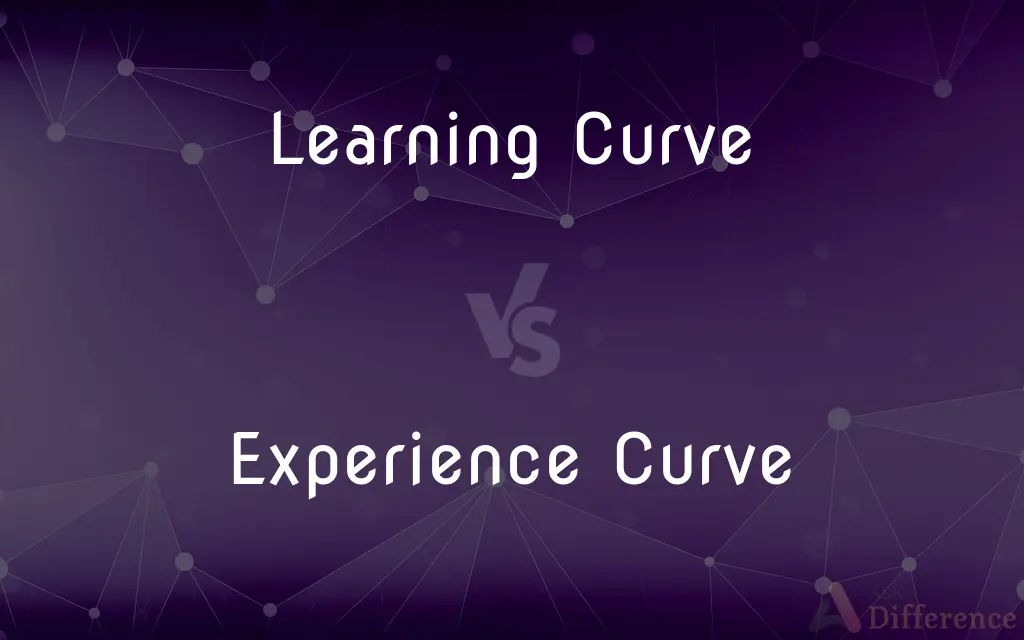Learning Curve vs. Experience Curve — What's the Difference?
Edited by Tayyaba Rehman — By Fiza Rafique — Published on December 13, 2023
The learning curve depicts how proficiency grows with experience, while the experience curve shows how costs decline with increased production volume. Both involve efficiency over time.

Difference Between Learning Curve and Experience Curve
Table of Contents
ADVERTISEMENT
Key Differences
The learning curve and the experience curve, while related in concept, have distinct applications and implications. The learning curve represents the rate at which an individual or organization becomes more efficient or skilled at a task with increasing experience. As more tasks are performed, the time taken, or errors made generally decrease, reflecting enhanced proficiency. This can be observed in numerous settings, such as a new employee becoming faster at a job over time.
On the contrary, the experience curve focuses on the broader scale of production and economics. It illustrates how the per-unit cost of production or service provision tends to decrease as the total quantity produced increases. The underlying idea is that as companies gain experience in producing a particular good, they find ways to do it more efficiently, leading to cost reductions. This efficiency is not just due to learning but also factors like economies of scale and improved processes.
It's crucial to note that while the learning curve is often applied at an individual or team level, the experience curve typically applies to organizations or industries. The learning curve suggests that with practice, one can become better at a particular task or skill. The experience curve, on the other hand, signifies that as a company produces more, it benefits from reduced costs, which can give it a competitive advantage in the market.
Understanding both curves is pivotal for businesses and individuals alike. Recognizing the learning curve helps in anticipating the time and effort required to master a new skill or process. Being aware of the experience curve can guide businesses in pricing strategies, competitive positioning, and production decisions, capitalizing on the cost advantages that come with increased experience.
Comparison Chart
Focus
Skill or proficiency improvement over time
Cost reduction with increased production volume
ADVERTISEMENT
Application
Individual or team
Organization or industry
Underlying Concept
Efficiency gains through repetition and experience
Economies of scale and process improvements
Measurement
Time taken, errors made, proficiency
Per-unit production cost
Implication
Mastery over a skill or process with practice
Competitive advantage through reduced costs
Compare with Definitions
Learning Curve
A graphical representation of how proficiency increases with experience.
As she practiced more, the steep learning curve of the software became evident.
Experience Curve
A graph showing declining production costs as output increases.
The company's experience curve indicated substantial cost savings as they ramped up production.
Learning Curve
A depiction of the challenges faced when learning something new.
The first few weeks of flying lessons have a steep learning curve.
Experience Curve
A representation of economies of scale and other efficiencies gained over time.
The industry's experience curve was a vital factor in setting competitive prices.
Learning Curve
The progression in acquiring a new skill or knowledge over time.
The learning curve for the new language was challenging but rewarding.
Experience Curve
The phenomenon where costs reduce due to accumulated production experience.
As the factory expanded, the benefits of the experience curve became more pronounced.
Learning Curve
The rate of a person's growing understanding or competence in a particular area.
With hands-on experience, her learning curve in coding accelerated.
Experience Curve
The concept highlighting reduced unit costs with increasing production volume.
Their advantage in the market was largely due to the steep experience curve they had achieved.
Learning Curve
A measure of the time or effort needed to master a skill with increased practice.
The piano had a steeper learning curve than the guitar for him.
Experience Curve
The relationship between experience in production and efficiency gains.
With every new product launch, the company moved further down the experience curve.
Common Curiosities
What does the learning curve illustrate?
The learning curve illustrates how proficiency or skill improves with repeated practice or experience.
Is the experience curve focused on individual growth?
No, the experience curve primarily relates to organizational or industry-wide production cost reductions with increased volume.
Is the learning curve always positive?
While the general trend is positive, there can be temporary setbacks or plateaus in the learning process.
Is a steeper learning curve harder or easier?
A steeper learning curve typically indicates a more challenging initial learning process.
Can the learning curve apply to teams?
Yes, teams can also have a learning curve as they work together and improve their coordination and efficiency.
How does the experience curve affect pricing?
As production costs decrease due to the experience curve, businesses may adjust prices to maintain profitability or market share.
What's the relation between the learning curve and efficiency?
The learning curve shows that with increased practice, individuals or teams become more efficient at a task.
What factors contribute to the experience curve?
Factors include economies of scale, process improvements, and cumulative production experience.
Can a company have both a learning and experience curve?
Absolutely. A company can experience skill improvements (learning curve) and production cost reductions (experience curve) simultaneously.
Can learning curve insights be applied in educational settings?
Yes, understanding the learning curve can help educators tailor instruction methods and pacing.
How do businesses benefit from the experience curve?
Businesses can achieve cost reductions, set competitive prices, and optimize production strategies using the experience curve.
Share Your Discovery

Previous Comparison
Filtration vs. Reverse Osmosis
Next Comparison
Nintendo Wii vs. Wii MiniAuthor Spotlight
Written by
Fiza RafiqueFiza Rafique is a skilled content writer at AskDifference.com, where she meticulously refines and enhances written pieces. Drawing from her vast editorial expertise, Fiza ensures clarity, accuracy, and precision in every article. Passionate about language, she continually seeks to elevate the quality of content for readers worldwide.
Edited by
Tayyaba RehmanTayyaba Rehman is a distinguished writer, currently serving as a primary contributor to askdifference.com. As a researcher in semantics and etymology, Tayyaba's passion for the complexity of languages and their distinctions has found a perfect home on the platform. Tayyaba delves into the intricacies of language, distinguishing between commonly confused words and phrases, thereby providing clarity for readers worldwide.
















































